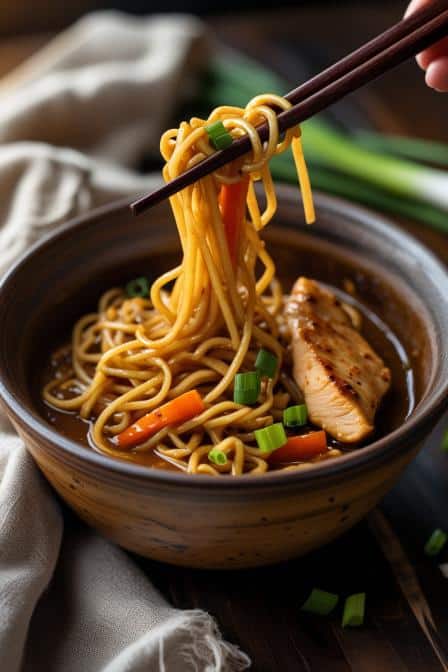Ever burnt your noodles and still tried to convince yourself it’s ‘extra crispy’? Yep. Been there, done that. Years back, I scorched an entire wok of chow mein so bad it smelled like charred regret. But funny thing is… it pushed me down the rabbit hole of truly understanding what makes a great Chicken Chow Mein—and why the sauce isn’t just sauce, it’s the soul.
You see, real Chicken Chow Mein isn’t your quick college-dorm hack or the limp takeout from last Tuesday. It’s a careful dance of textures: chewy noodles, crisp veggies, juicy chicken, all coated in a sauce so balanced it hums. And when you get it right? Oh, mate, it’s like the wok whispers secrets only you can hear.
What makes this Chicken Chow Mein special?
Not all chow mein are born equal, huh. This recipe builds on layers of technique and a sauce that hits all five tastes—sweet, salty, sour, bitter, umami. We’re not just tossing soy sauce and calling it a day. No sir. There’s oyster sauce for depth, sesame oil for aroma, a tiny splash of Chinese cooking wine for complexity. Fresh ginger and garlic? Non-negotiable.
And then there’s the method. High heat, quick movement, breathing life into the noodles so they don’t steam and go soggy. It’s classic Cantonese stir-fry magic. And believe me, you can taste when it’s done right.
Ingredients & Substitutions
Alright, let’s lay it all out before the wok gets hot.
| Ingredient | Why it matters | Substitutes / Notes |
|---|---|---|
| Egg noodles (fresh or dried) | Chewy bite, classic texture | Udon, lo mein, or even spaghetti in a pinch |
| Chicken breast, thinly sliced | Quick to cook, stays tender | Chicken thigh for juicier bite |
| Soy sauce (light) | Salty backbone | Tamari (gluten-free) |
| Dark soy sauce | Color, slight sweetness | Double light soy + pinch of sugar |
| Oyster sauce | Deep umami | Vegetarian oyster sauce or hoisin |
| Chinese cooking wine (Shaoxing) | Complexity, aroma | Dry sherry |
| Sesame oil (toasted) | Nutty aroma | Skip if allergic, but flavor will lack |
| Fresh ginger & garlic | Bright heat and fragrance | Powdered in emergency, but fresh is leagues better |
| Carrots & cabbage | Sweetness & crunch | Bell peppers, snow peas, bean sprouts |
| Green onions | Sharpness & color | Chives or shallots |
| Cornstarch slurry | Thickens sauce to coat | Arrowroot powder |
| Sugar & white pepper | Balance | Black pepper if you must |
Little tip: if you can get high-protein flour noodles, they hold chew better. And fresh veggies always beat pre-cut. Your wok deserves it.
Step-by-Step Instructions
Step 1: Prep everything first.
Seriously. Slice chicken thin against the grain. Julienne veggies. Mix sauce in a bowl: light soy, dark soy, oyster sauce, Shaoxing wine, sesame oil, sugar, white pepper. Have cornstarch slurry ready. Wok cooking is over in minutes; you won’t have time to chop once flames dance.
Step 2: Boil noodles till just shy of al dente.
Drain and toss with a drop of oil to stop sticking. Overcooked noodles = mushy sadness. Undercooked? Chewy like rubber bands.
Step 3: Heat wok screaming hot.
Add neutral oil. Toss in chicken. Quick stir, don’t overcrowd or it’ll steam. Chicken turns golden in spots, just cooked. Remove and set aside.
Step 4: Aromatics hit next.
Ginger, garlic, quick sizzle—don’t burn ‘em. Smells like heaven? Good.
Step 5: Veggies join the party.
High heat keeps ‘em vibrant and crunchy. Stir constantly.
Step 6: Noodles back in, then chicken.
Pour in sauce. Toss fast. Add cornstarch slurry last minute till sauce clings.
Step 7: Finish with green onions and extra sesame oil.
Expert tips?
- Use a carbon steel wok; it heats crazy fast.
- Shake off excess water from noodles or sauce thins out.
- Dark soy colors the noodles. Don’t overdo or it turns bitter.
Mistakes to dodge?
- Low heat = soggy, oily mess.
- Dumping all at once overloads wok. Stir in batches if needed.
Variations?
- Add chili flakes for heat.
- Swap chicken for beef, shrimp, or tofu.
- More veg? Mushrooms, bok choy, snap peas.
Cooking Techniques & Science
Why screaming heat?
It’s about the Maillard reaction. Browning brings flavor. High heat evaporates moisture fast so noodles fry instead of steam.
Cornstarch slurry?
It traps sauce onto each strand, so it clings rather than puddling at the bottom.
Shaoxing wine?
Alcohol evaporates, carrying aroma into your nose. Adds complex fermented notes.
Fresh vs. dried noodles?
Fresh give springy bite. Dried need careful timing; cook till just chewy.
Tools matter.
Wok’s rounded bottom helps toss food evenly. Flat pan? Possible, but keep stirring.
Storage & Reheating?
Cool quickly. Fridge up to 3 days. Reheat in wok or skillet over medium, splash water to loosen sauce. Microwave? Only if desperate—kills texture.
Vegan or gluten-free?
- Tofu for chicken.
- Gluten-free tamari, rice noodles instead of wheat.
- Vegan oyster sauce or hoisin.
Serving & Pairing Suggestions
Plating isn’t just pretty—it’s appetite. Big shallow bowl, twirl noodles high. Scatter extra scallions. Sesame seeds or chili oil drizzle look lush.
Pair with:
- Hot jasmine tea or cold barley tea.
- Light soup like miso or egg drop.
- Cucumber salad for crunch and contrast.
For drinks? Crisp lager or chilled white wine. Bubbles cut through sauce richness.
Best time to serve or eat this dish
Fresh off the wok, when steam fogs your glasses and the sauce still hugs every noodle. Late dinner with friends, lazy weekend lunch, even next-day lunchbox (though nothing beats fresh). Midnight cravings? Been there too.
Conclusion
Chicken Chow Mein done right isn’t complicated—but it is deliberate. It’s heat, speed, and a sauce built on balance. Keep your knife sharp, wok hot, and sauces ready. Taste and tweak; your palate’s the final judge.
Remember: don’t overcrowd. Trust your senses. Smell, listen, taste. And never walk away from a hot wok.
Last tip? Make extra sauce. You’ll want it.
FAQs
1. Can I use spaghetti instead of chow mein noodles?
Yes, cook till chewy, rinse well, toss in oil to stop clumping. Won’t be exactly the same, but still tasty.
2. Why does my chow mein turn soggy?
Wok too cold, too many noodles at once, or wet veggies. Keep heat high, batch cook if needed.
3. What’s the difference between lo mein and chow mein?
Chow mein noodles get stir-fried till slightly crisp. Lo mein noodles just get tossed in sauce.
4. Is dark soy sauce necessary?
For color and mild sweetness, yes. But light soy with sugar can fill in.
5. Can I freeze chicken chow mein?
Not recommended—noodles go mushy. Better to refrigerate and eat within 3 days.
So go on—grab your wok, chase that sizzling aroma, and make chow mein worth every bite. The kind that tells its story with each mouthful.

